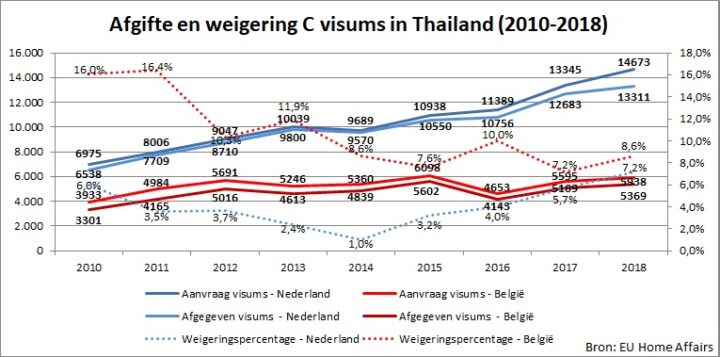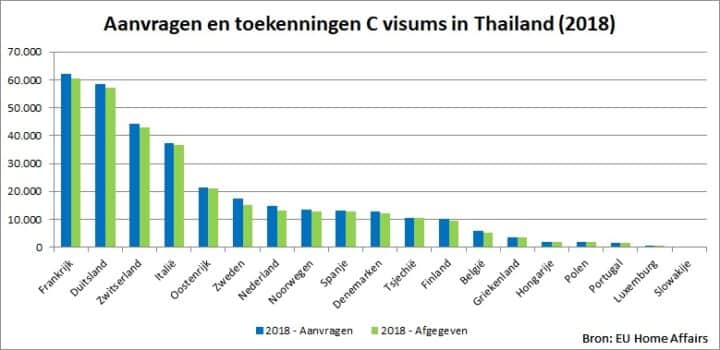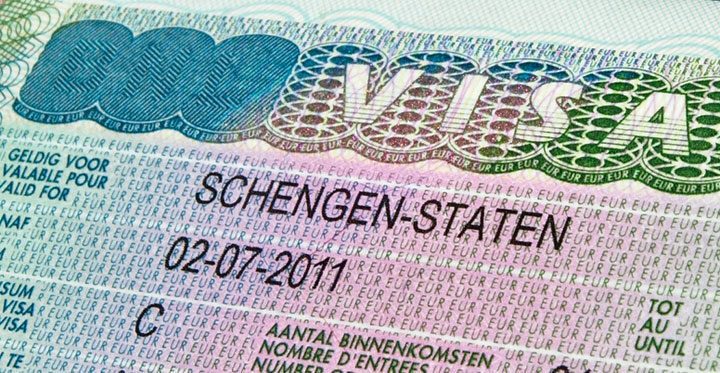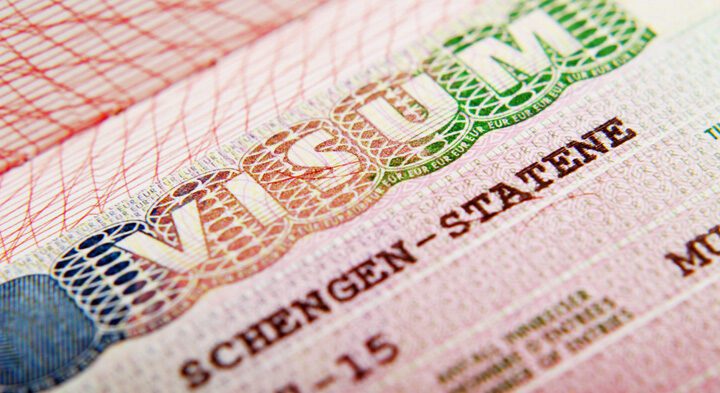Issuing Schengen visas in Thailand under scrutiny (2018)

Every spring, EU Home Affairs, the Home Affairs department of the European Commission, publishes the latest figures on Schengen visas. In this article I take a closer look at the application for Schengen visas in Thailand and I try to provide insight into the statistics surrounding the issuance of visas to see if there are any striking figures or trends.
An extensive analysis of the figures is available as a PDF attachment: www.thailandblog.nl/wp-content/uploads/Afgifte-Schengenvisums-2018.pdf
What is the Schengen Area?
The Schengen area is a cooperation of 26 European member states that have a common visa policy. The Member States are therefore bound by the same visa rules, which are laid down in the common Visa Code: EU Regulation 810/2009/EC. This enables travelers to move within the entire Schengen area without mutual border controls, visa holders only need one visa - the Schengen visa - to cross the external border of the Schengen area. More information about the regulations can be found in the Schengen Visa Dossier: www.thailandblog.nl/visum-short-stay/dossier-schengenvisum-2019/
How many Thai came here in 2018?
Exactly how many Thai people came to the Netherlands, Belgium or one of the other member states cannot be said with certainty. Data is only available on the application and issue of Schengen visas, but it is not known exactly how many Thais crossed the Schengen border. It should also be noted that not only Thais can apply for a Schengen visa in Thailand: a Cambodian who has the right of residence in Thailand can also apply for a visa from Thailand. Thais will also apply for a visa from elsewhere in the world, for example those who live in the United Kingdom. The figures I mention are actually purely production figures of the paperwork that the posts (embassies and consulates) move in Thailand. Nevertheless, they give a good impression of the state of affairs.
Are the Netherlands and Belgium a popular destination for Thais?
In 2018, 13.311 visas were issued by the Netherlands for 14.673 applications. Belgium issued 5.369 visas for 5.938 applications. By way of comparison: in 2017, the Netherlands issued 12.683 visas for 13.345 applications. Belgium then issued 5.109 visas for 5.595 applications.
In total, more than 2018 visas were requested from the Schengen member states in Thailand in 332 and around 320 visas were issued. As in previous years, France and Germany were the most popular destinations. In 2018, it processed approximately 62,1 thousand and 58,4 thousand applications respectively. And Switzerland and Italy also take third and fourth place again. France (18,7%), Germany (17,6%), and Switzerland (13,3%) together received half of all Schengen visa applications in Thailand.
The Netherlands received 'only' 4,4% of all applications, which is seventh in popularity. Belgium received 1,8% of all applications, which puts it in thirteenth place. But do not forget that the visa is applied for at the country that is the main purpose, a Thai with a visa issued by Germany (main purpose) can of course also visit the Netherlands or Belgium for a short time, but this cannot be analyzed from the figures.
Were those Thai travelers mainly tourists or were they visiting a partner here?
The EU does not keep exact figures for each destination, so this cannot be determined exactly. The Netherlands was able to provide figures on the purpose of Thai travel: about 68% tourism, 20% to visit family or friends, 11% for business visits and 1% other. The Belgian authorities did not answer my questions this time. In the past, they indicated that their distribution was 46% tourism, 20% visits to friends, 10% family visits, 12% business and 12% other. Earlier Dutch estimates were comparable to those figures, so it is possible that the percentage of tourists has also increased among Belgians. Unfortunately, nothing can be said with certainty if the Belgian authorities do not respond to questions. Regrettably.

Are the Netherlands and Belgium strict?
Many of the Schengen embassies operating in Thailand refuse between 1 and 3 percent of applications. However, this does not apply to the Netherlands and Belgium, they -and the Scandinavian member states- show a completely different picture here. The Netherlands refused 2018% of Thai applications in 6,9. The number of rejections has increased in recent years, for example, the number of rejections was 4% in 2016 and 1% in 2014. The Netherlands is certainly no longer lenient.
The Belgian embassy rejected 8,6% of the applications. This is an increase from the 7,2% rejections in 2017. And this is also significantly more than most other Schengen embassies. If there were a trophy for most rejections, Belgium would take silver again. Only Sweden rejected even more: 10,4%.
Both the Netherlands and Belgium have already indicated that they check (more) strictly the completeness of applications and have therefore become less lenient in the absence of supporting documents. Instead of a recovery option, there is now a rejection. It is therefore extremely important that one obtains proper and complete information so that the application meets all requirements and is also complete. Use the checklists that are made available on the websites of the Dutch and Belgian authorities. Good preparation is half the job!
However, this does not fully explain the difference in rejections between the Netherlands and Belgium. It is obvious that people generally make different risk assessments for a specific travel purpose (tourism, visiting friends/family, business, etc.): For example, the risk of tourists (on an organized tour) is generally estimated to be lower than visiting family: the latter would – because of having friends or family in Europe – sometimes not returning to Thailand. Such a suspicion then results in a rejection on the basis of “danger of establishment”. However, the travel goals of Thai travelers for Belgium and the Netherlands were comparable in the recent past, while the Belgians have been rejecting much more for years than, among others, the Dutch officials. In general, the Belgians therefore seem to estimate the risks of Thai travelers to be higher and are therefore significantly stricter in that respect than most other Schengen Member States. As far as the Netherlands is concerned, I do not get the impression that the risks between the two main travel purposes (tourism and visiting friends/family) make a significant difference.

You can also see this difference in other areas: the Netherlands once again issued a relatively large number of multiple entry visas (MEV), with which an applicant can enter the Schengen area several times. As a result, an applicant has to apply for a new visa less often, which is great for both the applicant and the embassy. Since the introduction of the back office system, whereby Dutch visas are processed in Kuala Lumpur, almost 100% of all visas are MEVs. The RSO back office is pursuing this liberal visa policy throughout the region (including the Philippines and Indonesia): many of the visas are MEVs and the number of rejections in the region was a few percent last year. Belgium did not release nearly as much MEV, only 14%. I do expect a change in this in the future: since 2 February 2020, new rules have come into effect that more or less force the Member States to issue an MEV more often (unless this cannot be justified in individual cases).
Are many Thai people still refused at the border?
Not or hardly, according to Eurostat data. This statistical office of the EU collected figures, rounded to 5, about refusals at the border. According to these figures, only about 2018 Thai people were refused entry at the border in the Netherlands in 5, comparable to the 5 to 10 refusals in previous years. In Belgium, practically no Thai people have been refused entry at the border in recent years. Refusal of Thai at the border is therefore really a rarity. Nevertheless, I must advise that travelers prepare well: bring all the necessary supporting documents with them so that they can demonstrate that they meet the visa requirements when asked by the border guards. I advise the sponsor to wait for the Thai visitor at the airport so that they can also be reached by the border guard if necessary. In case of refusal, it is best not to have yourself sent back immediately, but to consult a (on-call) lawyer, for example.

Conclusion:
Every year the number of visa applications from Thailand increases, but unfortunately we see that the number of rejections also shows an increase in the past few years. The increase in the number of Thai people who want to travel to a Schengen country may also have led to an increase in the proportion of travelers who cannot meet the conditions of a visa. The Netherlands has indicated for a few years that it has become less lenient with incomplete files. This may also apply to the Belgians, although they were already notorious for the large number of rejections compared to most Member States. And like all previous years, we see that the Netherlands is generous with MEV, where Belgium and many other member states only issue MEV in small numbers. I do expect a change in this in the future: new rules will come into effect on 2 February 2020 that more or less force the Member States to issue an MEV more often (unless this cannot be justified in individual cases).
The vast majority of Thai applicants get their visa, and that gives a positive feeling. The bona fide traveler must really pay attention to whether their application is complete. So following the instructions that the embassies leave exactly is very important. Even though the Dutch government now only refers to the NetherlandsAndYou site and the VFS Global website as primary sources, these are still not entirely sufficient to point applicants in the right direction. In practice, one also has to consult other sites such as those of the IND, the national government and various blogs and forums in order to make a very sound application. Further integration so that all information and forms – for foreign nationals and sponsors – can be found on one (multilingual!) website are very welcome. Files could therefore be delivered in better condition.
Good preparation helps of course, for example with the help of the Schengen visa file on Thailand Blog. So don't forget to check the checklists before you submit an application!
Sources and backgrounds:
– Schengen visa statistics: http://ec.europa.eu/dgs/home-affairs/what-we-do/policies/borders-and-visas/visa-policy/index_en.htm#stats
– Schengen Visa Code: http://eur-lex.europa.eu/legal-content/NL/ALL/?uri=CELEX%3A32009R0810
– Refusal at the border: http://ec.europa.eu/eurostat/web/products-datasets/-/migr_eirfs
- https://www.thailandblog.nl/visum-kort-verblijf/afgifte-schengenvisums-thailand-loep-2017/
– Contact with the Dutch, Belgian and Swedish authorities (via the embassies and RSO). Thanks!
– I only started working with the figures in the late summer of 2019, in October I contacted the Dutch and Belgian authorities. The Hague gave a response in December, Brussels has never heard anything. I hope to be able to share the figures for 2019 in the summer of this year, if Brussels can also make itself heard…


Thanks for this interesting overview, Rob! As you emphasize, good preparation is essential. The core of this is to prevent or remove any doubts about the possible 'danger of establishment'.
It would also be interesting to know how many Thais have not returned. Once they have all returned in time, the policy can be relaxed. If a few hundred have disappeared, the policy may be too lenient. Are figures known about this? It is also possible that people with an incomplete application have submitted a 2nd application with complete data and for which a visa has still been issued. Then the percentage of rejections is actually less. Measuring is knowing.
Yes, to measure is to know, but not everything can be measured correctly. For example, someone can enter for a short stay on a Dutch visa, and then apply for residence in Germany with the Dutch partner (immigration under EU rules). That is completely legal, even if someone has not returned on the short-stay visa. For example, there are more scenarios that require more than 'the database of visa holders who cross the border, how many Thai people did not leave on time?'.
If you do not leave on time, your visa will have expired and from that moment on you will be illegal. In pieces about illegality/illegals I never read anything about Thai people. Of course, investigations into illegal immigrants continue to be random samples, but Thais do not seem to emerge as a risk group. A life as an illegal immigrant is not easy either, you can't really go anywhere. It is more likely that (Thai) visa visitors secretly go to work during their stay and then return on time. But there are no really alarming figures about that either. Thai and various others from the region seem to be at a much lower risk than, for example, people from (North) Africa. At embassies in those countries, we see rejection rates of around or over 50%.
Every year I also ask for an explanation for the rejections and increases. Time and time again, this has to do with incomplete files, fraud, etc. I also explicitly ask whether the risk profile has changed, the answer to which is always 'no'.
There are therefore no concrete figures on illegal activities. And I think there could be a separate article devoted to that subject, if anyone would like to dive into it.
From a few WODC reports on illegal immigrants:
“[Concerns] mainly men (80%), coming from 24 countries, mainly Africa and to a lesser extent Asia”
and: “illegally cannot receive benefits, cannot rent a home from a housing corporation and have no access to general benefits and facilities, even if they are aimed at combating poverty or shelter, such as the food bank or night shelters. Furthermore, illegal immigrants are entitled to education if they are younger than 18 and they must be able to receive medically necessary care and legal assistance. Even if illegal aliens want to remain unnoticed, there are times when they have to come into contact with (care) authorities or (aid) organizations that can support them in their daily lives.”
Sources / more:
– https://www.thailandblog.nl/visum-short-stay/Answers-jeannette-verkerk-visumvragen/
Preliminary research into data and methods for estimating illegal immigrants
– https://www.wodc.nl/onderzoeksdatabase/2917-vooronderzoek-bronzes-en-angerelingen-without-legal-stay.aspx
Estimates of foreign nationals residing illegally in the Netherlands 2012-2013
– https://www.wodc.nl/onderzoeksdatabase/2402-illegalenschat.aspx
Just went looking for figures on illegal aliens. From 'The Dutch Migration Map' (2012) the following data can be found. Figures from 1997-2003.. a bit outdated…
” More than 1997 nationalities were represented among the illegal aliens arrested in the period from 2003 to 200 (Leerkes, 2009). This mainly concerns subsequent migration from countries where
over time, migration flows to the Netherlands originate (Morocco, Turkey, China, Surinam), asylum countries (Iraq, Afghanistan, Somalia and various other African countries) and 'new' countries of labor migration to the Netherlands (Ukraine, India, Philippines). There is also migration from production and transit countries of prohibited drugs (Colombia, Turkey, Suriname), and from countries that are important
play a role in the international prostitution and relationship market (Thailand, Russia, Brazil, African countries).
(..)
By definition, illegal aliens hardly appear in the official statistics. In fact, because of the 'discouragement policy' they are
administratively increasingly invisible in the Netherlands. The regular population statistics of Statistics Netherlands offer little guidance for insight
in the number of illegal immigrants in the Netherlands and their background characteristics. (..)”
And then a lot of talk about databases of the police, KMar etc.
Source:
- https://www.cbs.nl/nl-nl/achtergrond/2012/04/arbeidsmigratie-belangrijkste-immigratiestroom
—–
This book 'Illegal aliens in the Netherlands'
from 2002 has figures on detained illegal aliens by country of origin:
149 Thais (out of 47.764 detained illegal aliens)
Source: https://repub.eur.nl/pub/1858
Interesting information Rob V but do you perhaps know the address (or someone else) of the RSO back office in Kuala Lumpur or is this located at the NL embassy?
MVG, Pjotr.
Dear Pjotr, The RSO is located in Kuala Lumpur at the Dutch Embassy in Malaysia. But you can't visit there or anything. They can be reached by email for managing documents, etc. They do not provide questions and answers to general contributions or the status of a file. That email address is:
asiaconsular [at] minbuza [dot] en
The plan was that the RSO would be closed in the fall of 2019 and all services would be handled digitally by the CSO in The Hague. Saves flying in and out of passport from Bangkok to Kuala Lumpur and back. A new date of transfer from RSO-Azi to the CSO is not yet known.
I submitted my last series of questions to the visa service in The Hague (Consular Affairs and Visa Policy Directorate, DCV-CC-KK). I did not email the RSO myself last year.
Thanks Rob, your answer is very helpful to me.
Piotr.
I took a quick look at my first article about the numbers, then there were 2 + 10 responses spread over 22 entries. Then a descending pattern towards below 10 reactions. The amazement of the first time will be gone, but I hope that the necessary readers will still find this useful. How many people download the PDF.. a few really curious people?
Well, if only a few people have been helped, it's already great. For example, I hardly get any responses to the Schengen questions I answer here. Then I assume that they have been helped so well that people are completely happy with the visa and forget about me. Although feedback is always nice, then I can take that knowledge with me to help other people again. Or my answer is so bad that the questioners have boycotted out of frustration. 🙂 555
Series 1, 2014:
- https://www.thailandblog.nl/dossier/schengenvisum/afgifte-schengenvisums-thailand/
- https://www.thailandblog.nl/dossier/schengenvisum/afgifte-van-schengenvisums-thailand-onder-de-loep-deel-2/
I take my hat off to your hard work from Rob V.
Good to read Rob that you quote in this piece, don't forget that the visa is applied for at the country that is the main target. So the Dutchman who wants to show his Thai girlfriend or boyfriend our beautiful country and therefore stays there most of the time, to make the application at the Dutch embassy or consul. The Belgians under similar circumstances with their own country authority, etc. If one intends to use the main residence in another Schengen country, then submit the application to the authority of that country. This week it was mentioned that if one encounters problems with the application, this can also be done at another Schengen country, because that would be less paperwork and evidence and more beneficial. I expressed my surprise at this. For supervisory reasons for the responsible country, this is of course inadvisable, unless you feel angry. But again I can agree with this and it is in accordance with the rules.